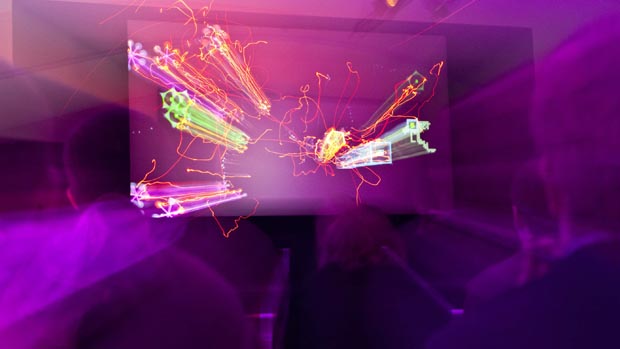 Back to selection
Back to selection
Transcendental Oneness
 Renga
Renga Maybe it was the weather. It was a warm night. Perfect Los Angeles, balmy, the reason people put up with that town.
I was in Culver City. It was the second night of IndieCade, and I was half an hour away from finding myself having what I can only describe as a transcendental experience.
IndieCade is the game world’s Sundance; I know I’ve written about it before in these pages, but bear with me.
I was walking around with one of my favorite game designers, Jonathan Blow, (Braid and, forthcoming, The Witness) At some point, we became aware of a movie screen looming up ahead of us, framed, beautifully, by the inky blue-black sky.
A hundred people were sitting on the sidewalk in front of the screen, their necks craned upward like people in an advertisement for the wonder of cinema. They were mostly quiet, though every few minutes waves of sound — groans, hurrahs, gasps, laughter — rippled through.
If I tell you the plot of the game, you’ll die instantly of boredom. Let’s just say there’s a ship, the need for harvesting some kind of unnamed resources, attackers and a Boss. But vanish from your mind all images this scenario conjures. Strip it down. Strip it down all the way to the simplest geometric shapes — slowly expanding yellow hexagons; a moving blue square; pink, six-pointed, stick-figure stars with illuminated purplish tips.
And across all of this, like some kind of electrified Jackson Pollock painting, red lights splattered across the screen. Sometimes the tips of the red lights careened about wildly; sometimes they seemed to congregate and flow toward the yellow hexagons; and sometimes they swarmed about the blue square.
Cinematic music soared.
I said something to Blow along the lines of “What in fuck’s sake…?”
Fortunately I was with someone in-the-know (or who had at least read the festival program). I was witnessing Renga; those hundred crossed-legged, mouths-agog people on the sidewalk were playing the game by working in tandem with a hundred laser controllers. Collaboratively, those hundred players were acting as a single controller — and they were doing it with only the most minimal screen instructions and without talking to one another.
In their conversations about the game, designers Adam Russell and John Sear tend to talk about its theatrical nature — the big screen, the fact that they’re in the back altering the game’s pace to match the crowd’s pace.
But that warm October night at IndieCade, Renga — named after a kind of 16th- and 17th-century, collaboratively written Japanese poetry — seemed like much more than just a new take on game as performance.
As I watched, the behavior of the red lights on the screen began to change. At first, they were all over the place, the wild splatters of Jackson Pollock. But as the game progressed, the behavior of the lights began to appear orchestrated — red dots of light circled the geometric “attackers,” defusing them, while other dots of light beamed on the square, keeping it moving and “harvesting.” But this was an orchestra with no conductor and no score, somehow managing to play an entire symphony, note by note. Hive mind as controller.
In the final scene, the Boss moves slowly across the screen. The Boss is an enormous circle made of smaller clusters of circles. To defeat the boss, a red light needs to be aimed on each one.
The crowd was nearly entirely quiet as the Boss made its way toward the blue square. At first, the red lights whizzed about frantically. Then, slowly, they began to form a circle on top of the circle on the screen. Slowly the dots stopped vibrating. At last the Boss was completely covered by all but a few flickers of red. The players on the L.A. sidewalk were silent, and the red lights on the screen were still. No sounds from the people. No whirring from the lights. A collectively held breath.
And when the Boss broke apart, people on the sidewalk stood up and cheered. They embraced one another. I found the hairs on my arm standing on end. Jonathan Blow is not a particularly cuddly guy, but I nearly grabbed him in a bear hug.
We live in a culture where nothing is valued more than the individual, yet the experience of letting go of one’s own personal identity, even for just a moment, was extraordinarily liberating. It was a moment of transcendental Oneness — our own individual identities submerged into something bigger; we acted as a whole rather than as a group of parts. It’s moments like these, I thought, when people become Buddhists, or, less ideally, Fascists.
It felt profound. But who knows. Maybe it was just the weather.
